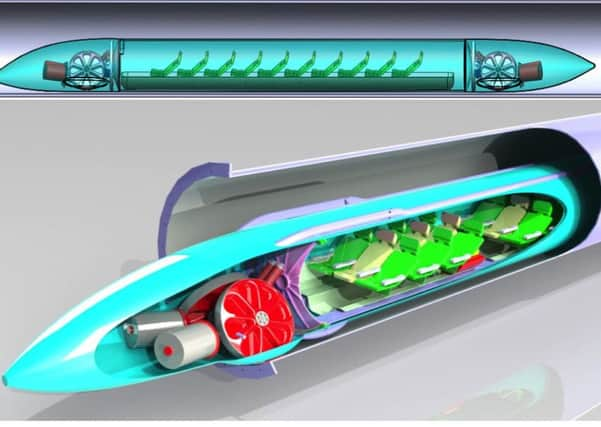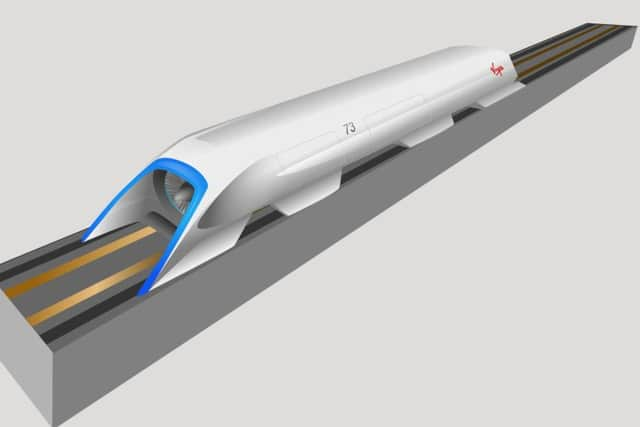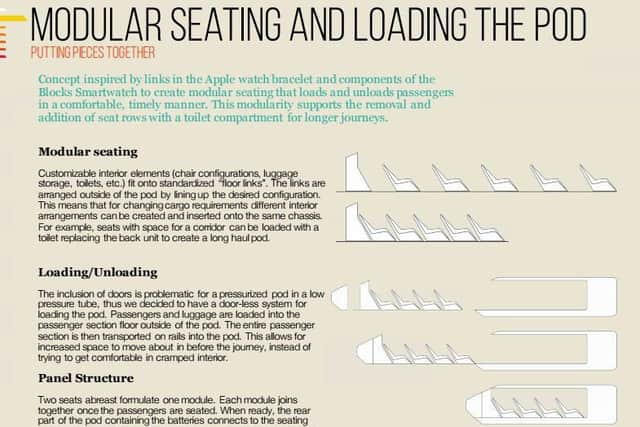Hyperloop transport: Edinburgh to London in less than 30 minutes?


It sounds like space-age transport straight out of a science fiction movie, but the Hyperloop could become a reality.
The futuristic idea was originally the brainchild of SpaceX entrepreneur Elon Musk, who is in the process of building a demonstration track in the Nevada desert.
Advertisement
Hide AdAdvertisement
Hide AdTravelling at speeds equivalent to a hypersonic jet, the Hyperloop would have the capability to travel from Edinburgh to London in roughly 30 minutes, making the capital-to-capital commute quicker than a train journey across the central belt.


Now, an ever-expanding team of around 30 members from the University of Edinburgh have entered a design competition to earn a place in the SpaceX Hyperloop design semi-finals in Texas this week.
Their design for the super-speed transportation contains a small capsule that can hold eight people, with the ability to reduce travel between Edinburgh and London to just 30 minutes.
Adam Anyszewski, one of the student engineers on the project said: “The Hyperloop capsule would be placed into a long tube, that would stretch a regularly commuted distance - such as Edinburgh to London, or Los Angeles to San Francisco.
“All the air is removed from the tube, to eliminate wind resistance. The capsule would then be powered towards London, using electricity, where passengers would arrive in around 35 minutes.


“These capsules would be launched roughly once a minute.”
Using electricity as a power source would make the Hyperloop a clean method of transport, and more green than its two equivalents - plane and train travel.
Fellow student, Gabrielis Cerniauskas said that the Hyperloop is one of the most environmentally friendly methods of travel:
“The capsule is able to travel at tens of miles without needing a boost, so it wouldn’t have to be continually powered.


Advertisement
Hide AdAdvertisement
Hide Ad“The idea would be that you could place solar panels along the outside of the tube so not only would it be self reliant on energy, but you could even sell off excess electricity back to the power grid.
“Once you’ve built it, the emissions from the loop would be zero. Literally no emissions. So it’s very environmentally friendly”
The project is still in the development stage, but after testing was completed, the hyperloop would potentially be ready for the first passenger by 2020.


The innovative engineers will present their own concept - created in collaboration with students from Edinburgh’s College of Art - to a panel at the American competition, who will judge the team on the project’s engineering and design merits.
When dealing with such phenomenal speeds, safety and comfort will be a significant factor for designers to consider.
The logistics of stopping the Hyperloop as it hits speeds of 700mph remains a challenge. The student team put a great deal thought into the interior design and calculated how much space passengers would need to feel comfortable so as reducing the risk of claustrophobia.
Their interior also borrowed concepts found in the links smart watches.
Peter Vaculciak, another engineer student in the team, praised the product designers on the team.
Advertisement
Hide AdAdvertisement
Hide Ad“The designers worked on many things - such as how different classes could have different seating; ways to put in lighting so it looks like there is more room; even down to the colour scheme - it can affect how big the pods look inside.”
“All of the materials needed to build a Hyperloop are actually available now,” said Vaculciak. “It’s just that the cost is so high, no one wants to invest.
And this cuts to one of the fundamental problems limiting Hyperloop progress so far: funding.
The ability to build the high speed tubes around heavily populated areas or even underground makes attractive when compared to high speed rail, in which often people must be displaced for ne lines to be built. Yet costs and return on investment remains a key issue. “I think it’s mostly just a lack of investors,” explains Anyszewski, “It’s not like an app, where there’s a quick development process with no overhead costs.
“When businessmen look to invest they see projects and they hear, ‘If you give me £1 million now, I’ll give you £4 million in two years.’ This project would be more like ‘If you give me £5 billion now, I’ll give you £6 billion in 20 years.’ The time period on returns may make it seem undesirable.”
“No board of director would make a decision on a project that has the potential to outrun their life on the board. They want to see fast results to ensure their position.
“The only way it may work, I think, is if a Government-backed third sector company went into it. Because you can’t look at profits during the development stage.
“You would have to employ hundreds of people, and generate losses for the first 10 years at least, before you start to see a turn around.
Advertisement
Hide AdAdvertisement
Hide AdHowever despite the barrier entries the test track being built in Nevada is tangible evidence that progress is being made.
But don’t throw out your rail pass just yet as it could be some time before we see Hyperloops in the UK.
